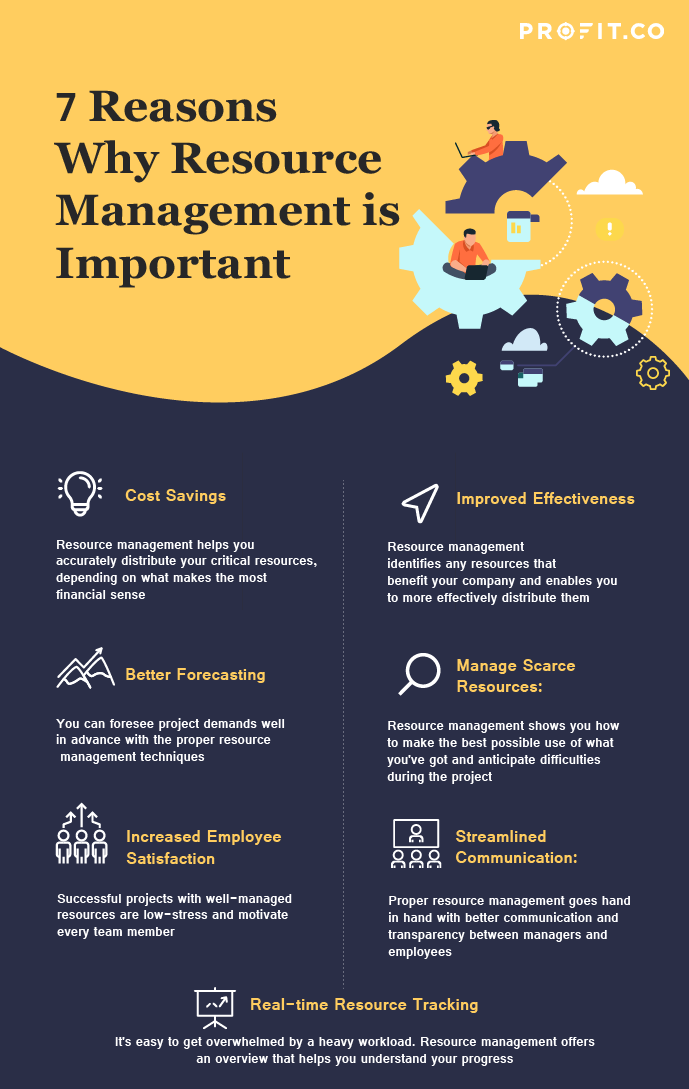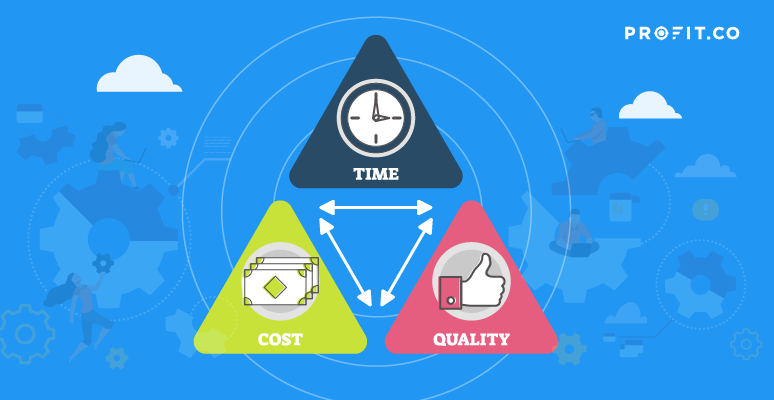The latest data from Finances Online indicates that 39% of the time, projects fail due to a change in business priorities. In fact, the leading performance indicator for a successful business is how precisely a team is able to meet their original business goals. This KPI ranks even higher than the budget, time, and scope of each project.
So how do you strike the right balance between your company goals, time and financial constraints, and a diverse range of employees? The secret is resource management.
Deciding what not to do is as important as deciding what to do.
Let’s dive right into resource management and why it’s crucial for your business’s success.
What Is Resource Management?
Resource management is the process of allocating the right resources, for the right time and the right work. A resource is everything you need to execute a project, and it can be tangible or intangible.
Tangible resources include:
- Equipment
- Finances
- Premises
- Supplies
Intangible resources include time and human resources. Resources also have other qualities. They can be:
- Single-use or reusable
- Internally sourced from within the organization
- Externally sourced from suppliers
Resource management means;
- Planning
- Scheduling, and
- Assigning these resources to meet your project goals
7 Reasons Why Resource Management is Important

You don’t have to wait until a project fails to realize that resource management is crucial for your business’s success. Here are the top 7 reasons resource management is important for your business:
1. Cost Savings
Resource management helps you accurately distribute your critical resources, depending on what makes the most financial sense. Meaning that you spend considerably less on your business projects because you use every resource well.
2. Improved Effectiveness
Resource management identifies any resources that can benefit your company. Otherwise, you can reallocate any underutilized funds, skills, equipment, or locations to suitable business activities.
3. Better Forecasting
You can foresee project demands well in advance with the proper resource management techniques. Before impacting your projects, you can spot resource shortages or skill gaps and make smart decisions to mitigate these challenges.
4. Manage Scarce Resources
Depending on the industry, you may encounter projects that meet market demands but have limited resources. This may be in terms of time, capital, expertise, or supply chain challenges. Resource management shows you how to make the best possible use of what you’ve got and anticipate difficulties during the project.
5. Increased Employee Satisfaction
Successful projects motivate every team member because they play an active role and aren’t under too much stress due to strained resources. On the flip side, if you have a high project failure rate, your team becomes demotivated and burned out, which fuels turnover rates.
6. Streamlined Communication
A core part of resource management is communication, which aids transparency in every project. Keep in mind that managers rarely work on a single undertaking at a time. In fact, 59% of managers have between 2 and 5 projects running simultaneously, with 15% of managers running more than ten projects at a time. Resource management software can be used as a platform to share and update information with your team and stakeholders.
7. Real-time Resource Tracking
If your business operates in various locations with hundreds of resources and employees performing different tasks simultaneously, it’s easy to get overwhelmed by all that’s going on. Resource management offers an overview of all your resources to help you understand your progress.
A dashboard view on resource management software highlights updates in real time and enables you to monitor:
- Teams
- Schedules
- Budgets
- Milestones
Are you looking for a software that enables you to transparently track and manage your OKRs? Check out Profit.co’s OKR Management software and get started free today!
What Are the Types of Resource Management?
The resource management process depends on your industry, project type, and size. That said, three main types of resource management cut across contexts:
1. Resource Scheduling: This ensures that your time and capacity match your project.
2. Resource Planning: This factors the past, current, and future projects to ensure that you dedicate your resources to the right job.
3. Portfolio Management: This evaluates your entire project portfolio for long-term planning and resource utilization.
How to Implement Resource Management Techniques
Resource management involves four main techniques:
1. Resource Allocation
Simply put, resource allocation gives you the greatest value out of your resources. Consider your team’s skills, available budget, and project schedule to understand the best way to assign these resources during the project planning process. Choose resource management software with resource allocation reports to optimize your projects.
2. Resource Utilization
This technique shows you exactly where you allocate your resources. For example, you can identify where your team is spending the most time and expertise or how their skills would be more productive.
Resource utilization helps you improve your team’s effectiveness, prevent burnout and manage workloads. Resource utilization also gives you insight into the scarcity or abundance of your resources over time.
3. Resource Leveling
Resource leveling helps to balance overused, underused, and ineffectively used resources. For example, team members may feel underused if they have additional skills that you cannot apply to the project.
A marketer with design skills would be better off developing creative content strategies for the business instead of answering customer calls or chasing sales leads. Manual data entry is also notoriously dull, error-prone, and ultimately quite expensive. A resource manager can invest in data automation then reallocate that time to better use.
1. Resource Forecasting
Resource forecasting means that you understand;
- Your project lifecycle
- Business objectives, and
- Available resources before you initiate your project
More specifically, you must have a good grasp on past projects, current team members, financial constraints, and lessons learned to more accurately predict the outcome of your project. Resource management software uses the following project factors for forecasting:
- Project scope and type
- Project budget
- Team member skills and availability
- Freelance or outsourcing opportunities
- Project schedule, including absence from work
- Extra project effort on top of current workloads
Resource Management Stages
There are four main stages of resource management to guide your business projects:
Step 1: Resource Estimation
Resource managers must understand what is necessary to execute their projects regarding people, time, budget, materials, and customer expectations.
Use resource management software to compare different scenarios: test your outcomes against different time schedules, in-house versus outsourced teams, locations, etc. The more the variables, the more accurate your resource estimation will be.
Step 2: Team Mobilization
Understand which team member has which skills to suit which project tasks. If any necessary skills are missing from your team, hire freelancers or outsource the project.
Step 3: Project Collaboration
A resource manager must clearly define every team member’s role and responsibility in the business. Keep everyone on the same page using resource management software at every stage of your project. You can also incentivize information sharing and contributing to the learning culture to encourage your team to give regular feedback on resource usage.
Step 4: Resource Monitoring
The resource monitoring stage checks your allocated resources’ progress, efficiency, and effectiveness. This is where you lookout for opportunities for improvement. Resource monitoring helps you prioritize and optimize your available resources to deliver on business goals.
Conclusion
All successful businesses have a noteworthy resource management strategy in place. Otherwise, project failures become too frequent, employee and client turnover escalates, and your bottom line suffers poor fiscal performance. Resource management ensures consistent performance in every project regardless of the company size and industry. Use these resource management techniques to meet your business goals today.
For more information about how Profit.co’s integrated OKR management software can help you better manage your project goals and even set targets for managing your resources, book a free demo with our experts!

